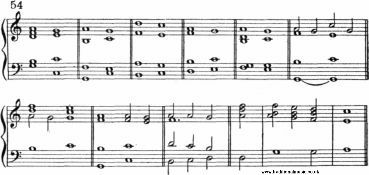EXTEMPORE PLAYING - online tutorial
40 Lessons in how to correctly play improvisations.
| Share page | Visit Us On FB |
|
LESSON XVII |
||
|
Dominant Ninths
Another third added to the dominant seventh gives the chord of the ninth. This is treated in a way similar to the former chord. The ninth tends downwards; it resolves either (i) with the seventh, down one step into the tonic chord; or (2) it goes down first while the seventh waits: or (3) it passes in chord-line, like the seventh; or (4) it may have a 'passive' resolution.
In vocal composition the root of this chord is generally omitted in inversions, though in instrumental music, especially in that for the keyboard, this plan is not invariably followed.
The ninth is usually placed above the 3rd, especially in vocal music.
It will be well for the student to follow the vocal plan at first. Later, when he has gained efficiency, he may take a freer course.
The ninth-chord offers many possibilities for charming effects, and should be carefully studied. The following are a few ways of using it. |
||
 |
||
|
It will be seen that the full chord contains five notes. When playing in four parts one note will, obviously, have to be omitted, and this will be the fifth. The keyboard composer may, however, if he wishes, introduce an extra |
||
|
[44] |
||